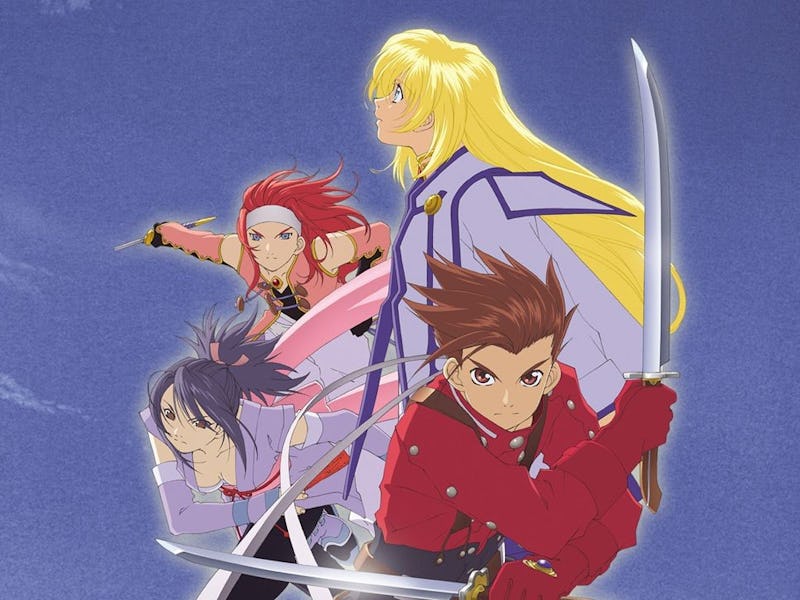How an Overlooked GameCube Game Changed RPGs For the Better
A Tale for the ages.

Setting off from the sleepy forest village of Iselia, a gang of young heroes embark on a quest to save the world. Yes, that setup sounds about as stereotypical as possible, but it’s entirely intentional to lay the groundwork for a masterful subversion of tropes. And 20 later, it remains one of the best RPGs ever made, and a pivotal turning point for Bandai Namco’s long-running franchise.
Tales of Symphonia was released on the Nintendo GameCube in 2004, a system that was notoriously light on RPGs. That was a bit surprising considering the legacy of the Nintendo 64 and SNES, and it gave Tales of Symphonia a big moment to capitalize on, becoming one of the defining RPGs of the console.
Tales of Symphonia features a fantastic cast of characters, each of which has their own compelling narrative arc.
Tales of Symphonia takes place in the world of Sylvatrant, a realm made up of various countries and races that’s dominated by a worldwide religion called the Church of Martel. You play as Lloyd Irving, a young boy who’s grown up in the little out-of-the-way village of Iselia with his childhood friends Colette and Genis. The trio has spent their whole lives knowing Colette is the “Chosen” who will one day be called upon by the Church to set out on a pilgrimage to “Regenerate” the world and save it. Working against them is an organization known as the Desians, half-elves that see all other races as inferior and have set up “human ranches” where they use humans as slave labor. (From here on, keep in mind we’ll be discussing major spoilers for Tales of Symphonia.)
For the first dozen hours, things play out as you might expect. The Desians are incredibly evil bad guys, you collect a few party members, hit some dungeons, typical RPG stuff. But about halfway through, Tales of Symphonia throws things for a massive loop, revealing the existence of two different worlds, a conspiracy to control both, and the astounding fact that the “Chosen” and the entire church and religious system of Sylvarant is a complete sham.
From here Symphonia layers in twist after twist, providing fascinating spins on typical character archetypes and storytelling techniques. Every character in Symphonia is intentionally built around an archetype: Lloyd is the hot-headed hero, Rain is the nagging mentor, Zelos is an aloof playboy, and Regal is the brooding man with a dark past.
Despite great art direction, Tales of Symphonia shows its age as the first fully 3D game in the series.
But each character is also layered to put a spin on those tropes, with their own arc that plays out alongside the main narrative. Regal ends up finding forgiveness for his past crimes and moving forward, Rain realizes she can learn as much from her mentees as they can from her, and Lloyd becomes a stalwart leader able to recognize his faults. There’s even a shocking moment where Zelos betrays the party, and the choices you’ve made can either lead to forgiveness for him, or his complete demise.
Symphonia manages to subvert your expectations, baiting players with RPG tropes we’ve seen time and again, before turning them on their heads. It also has some bold indictments of both racism and organized religion.
Symphonia is absurdly ambitious with its storytelling, and for the most part, it largely pays off. The Tales series had toyed with subversion before, but this felt like a real turning point that let the franchise flourish with its ideas. From here, we’d see both Tales of the Abyss and Vesperia subvert the idea of RPG heroes and identity, Berseria play with morality and history, and Arise tackle some of the same ideas as Symphonia. Subverting narrative tropes and archetypes became a key pillar of the franchise, and most of those foundations can be drawn back to Symphonia.
It’s a shame, then, that the game hasn’t aged incredibly well. Bandai Namco “remastered” it multiple times: on PS2 in Japan, on PS3 worldwide, and then again on modern consoles. But all of those versions simply upscale the graphics without changing the core of Symphonia’s gameplay, which is easily what’s aged the worst.
Symphonia’s combat is easily its weakest aspect, feeling slow and unwieldy compared to later games.
Symphonia was the first Tales game to make the jump to 3D, and it shows. A lot of Symphonia’s gameplay feels needlessly stiff and janky, a sign of the series finding its legs with the transition. Combat especially is slow and unwieldy, lacking a lot of the punch and responsiveness that later games would add. At the same time, the visuals often look a bit muddy, and the most recent remaster did almost nothing to update them outside of bumping up the resolution. As good as the core narrative is, some of the writing surrounding it can feel a bit awkward and cliche — this is a niche RPG from 2004 after all.
More than anything, though, it’s a case that Tales of Symphonia feels like the perfect candidate for a full remake, especially with the smash-hit success of 2021’s Tales of Arise, and the resurgence of RPGs as a whole. It’s utterly baffling that Bandai Namco hasn’t tried to capitalize on both of those facts and instead has let the Tales series’ momentum pitter out for three years. It’s great that a pivotal game like Symphonia is still playable on modern platforms, but it’s undeniable that it could be so much more.